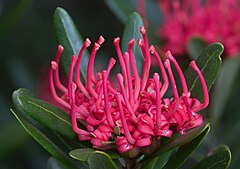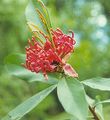Telopea
| Telopea subsp. var. | Waratah | |||||||||||||||||||||||||||||||||||||||||||||||||||||||
|---|---|---|---|---|---|---|---|---|---|---|---|---|---|---|---|---|---|---|---|---|---|---|---|---|---|---|---|---|---|---|---|---|---|---|---|---|---|---|---|---|---|---|---|---|---|---|---|---|---|---|---|---|---|---|---|---|

|
|
| ||||||||||||||||||||||||||||||||||||||||||||||||||||||
| ||||||||||||||||||||||||||||||||||||||||||||||||||||||||
Waratah (Telopea) is a genus of five species of large shrubs or small trees in the Proteaceae, native to the southeastern parts of Australia (New South Wales, Victoria and Tasmania). They have spirally arranged leaves 10-20 cm long and 2-3 cm broad with entire or serrated margins, and large, dense flowerheads 6-15 cm diameter with numerous small red flowers and a basal ring of red bracts. The name waratah comes from the Eora Aboriginal people, the original inhabitants of the Sydney area.
| Standard Cyclopedia of Horticulture |
|---|
|
Telopea (Greek, seen at a distance, of fanciful application). Proteaceae. Tall shrubs, occasionally grown in the greenhouse and one species has been experimented with in S. Calif., but so far has not proved very successful. Lvs. alternate, entire or dentate: fls. showy, red, hermaphrodite, twin-pedicelled, densely racemose; racemes terminal, subglobose or ovoid; bracts exterior, membranaceous, colored; perianth-tube elongated, segms. at length more or less separated; disk fleshy, strongly oblique but almost perfectly annulate; ovary long-stipitate, many-ovuled: follicle stipitate, oblique, leathery, recurved.—Three species, 2 Australian, 1 Tasmanian. An earlier name of the genus is Hylogyne, but Telopea is included in the list of "nomina conservanda accepted by the Vienna Congress. CH
|
Cultivation
Waratahs are popular, though somewhat tricky to grow, ornamental plants in gardens in Australia.
Propagation
- Do you have propagation info on this plant? Edit this section!
Pests and diseases
- Do you have pest and disease info on this plant? Edit this section!
Species
The five species all occupy distinct ranges with minimal or no overlap; listed from north to south:
- Telopea aspera Crisp & P.H.Weston - Gibraltar Range Waratah or New England Waratah. Northeast New South Wales.
- Telopea speciosissima (Sm.) R.Br. - New South Wales Waratah. East New South Wales.
- Telopea mongaensis Cheel - Braidwood Waratah or Monga Waratah. Southeast New South Wales.
- Telopea oreades F.Muell. - Gippsland Waratah or Victorian Waratah. Southern Victoria.
- Telopea truncata (Labill.) R.Br. - Tasmanian Waratah. Tasmania.
The New South Wales Waratah is native to areas in the Sydney geological basin, Central and South Coast districts, and in the Blue Mountains; it grows to about 4 m tall. It typically grows in sandy loam soils along ridges and plateaus. This waratah is endemic to New South Wales, but has now spread due to its popularity, to Victoria and even Tasmania.
Several hybrids and cultivars have been developed, including some with creamy-white and pink flowers as well as the natural red. White forms of Telopea speciossisima are named Telopea "Wirrimbirra White" and T. "Shady Lady White", while T. "Shady Lady Pink" and T. "Shady Lady Red" are actually hybrids between Telopea speciosissima and Telopea oreades.
Gallery
If you have a photo of this plant, please upload it! Plus, there may be other photos available for you to add.
Telopea mongaensis at Monga National Park
References
- Standard Cyclopedia of Horticulture, by L. H. Bailey, MacMillan Co., 1963



